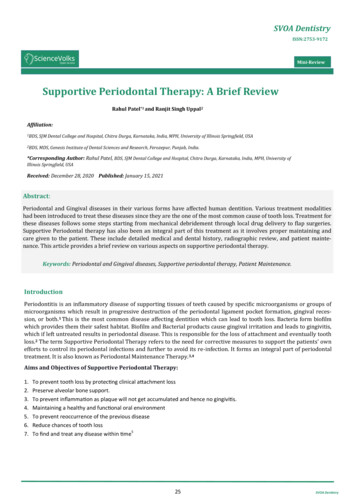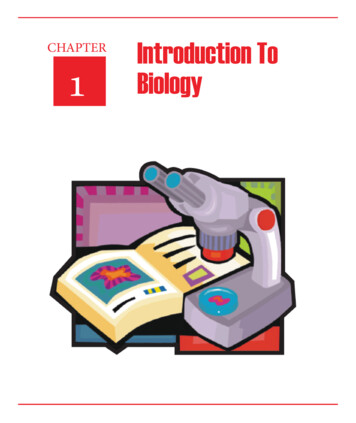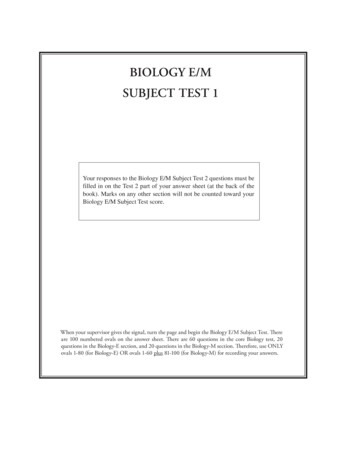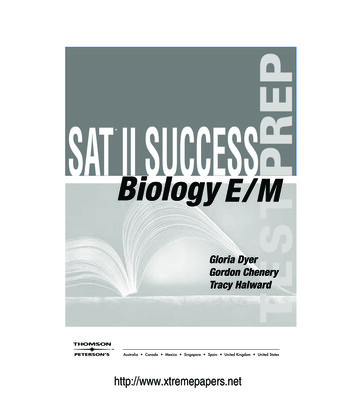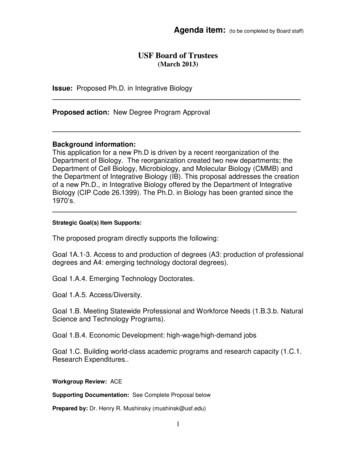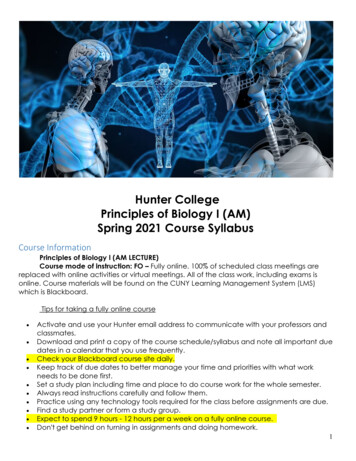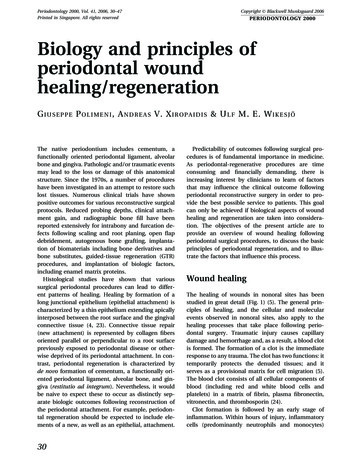
Transcription
Periodontology 2000, Vol. 41, 2006, 30–47Printed in Singapore. All rights reservedCopyright Blackwell Munksgaard 2006PERIODONTOLOGY 2000Biology and principles ofperiodontal woundhealing/regenerationG I U S E P P E P O L I M E N I , A N D R E A S V. X I R O P A I D I S & U L F M. E. W I K E S J ÖThe native periodontium includes cementum, afunctionally oriented periodontal ligament, alveolarbone and gingiva. Pathologic and/or traumatic eventsmay lead to the loss or damage of this anatomicalstructure. Since the 1970s, a number of procedureshave been investigated in an attempt to restore suchlost tissues. Numerous clinical trials have shownpositive outcomes for various reconstructive surgicalprotocols. Reduced probing depths, clinical attachment gain, and radiographic bone fill have beenreported extensively for intrabony and furcation defects following scaling and root planing, open flapdebridement, autogenous bone grafting, implantation of biomaterials including bone derivatives andbone substitutes, guided-tissue regeneration (GTR)procedures, and implantation of biologic factors,including enamel matrix proteins.Histological studies have shown that varioussurgical periodontal procedures can lead to different patterns of healing. Healing by formation of along junctional epithelium (epithelial attachment) ischaracterized by a thin epithelium extending apicallyinterposed between the root surface and the gingivalconnective tissue (4, 23). Connective tissue repair(new attachment) is represented by collagen fibersoriented parallel or perpendicular to a root surfacepreviously exposed to periodontal disease or otherwise deprived of its periodontal attachment. In contrast, periodontal regeneration is characterized byde novo formation of cementum, a functionally oriented periodontal ligament, alveolar bone, and gingiva (restitutio ad integrum). Nevertheless, it wouldbe naive to expect these to occur as distinctly separate biologic outcomes following reconstruction ofthe periodontal attachment. For example, periodontal regeneration should be expected to include elements of a new, as well as an epithelial, attachment.30Predictability of outcomes following surgical procedures is of fundamental importance in medicine.As periodontal-regenerative procedures are timeconsuming and financially demanding, there isincreasing interest by clinicians to learn of factorsthat may influence the clinical outcome followingperiodontal reconstructive surgery in order to provide the best possible service to patients. This goalcan only be achieved if biological aspects of woundhealing and regeneration are taken into consideration. The objectives of the present article are toprovide an overview of wound healing followingperiodontal surgical procedures, to discuss the basicprinciples of periodontal regeneration, and to illustrate the factors that influence this process.Wound healingThe healing of wounds in nonoral sites has beenstudied in great detail (Fig. 1) (5). The general principles of healing, and the cellular and molecularevents observed in nonoral sites, also apply to thehealing processes that take place following periodontal surgery. Traumatic injury causes capillarydamage and hemorrhage and, as a result, a blood clotis formed. The formation of a clot is the immediateresponse to any trauma. The clot has two functions: ittemporarily protects the denuded tissues; and itserves as a provisional matrix for cell migration (5).The blood clot consists of all cellular components ofblood (including red and white blood cells andplatelets) in a matrix of fibrin, plasma fibronectin,vitronectin, and thrombosporin (24).Clot formation is followed by an early stage ofinflammation. Within hours of injury, inflammatorycells (predominantly neutrophils and monocytes)
Biology and principles of periodontal wound healing/regenerationEarlyphaseLatephaseFig. 1. Phases of wound healing (epidermal incisionalwounds), including an early (within hours) and a late(within days) phase of inflammation dominated by polymorphonuclear neutrophils and macrophages, respectively. The magnitude of wound contraction parallels thephase of granulation tissue formation. Collagen accumulation is first observed during the phase of granulationtissue formation, continuing through the phase of matrixformation and remodeling. Redrawn with permissionfrom Dr Richard AF Clark.populate the clot. These cells cleanse the wound ofbacteria and necrotic tissue through phagocytosisand release of enzymes and toxic oxygen products.Within 3 days, the inflammatory reaction moves intoits late phase. Macrophages migrate into the woundarea and, in addition to wound debridement, secretepolypeptide mediators targeting cells involved in thewound-healing process (5, 45).The macrophage plays an important role in theformation of granulation tissue. Growth factors andcytokines secreted by macrophages are involved inthe proliferation and migration of fibroblasts,endothelial cells, and smooth muscle cells into thewound area. The cell-rich granulation tissue nextundergoes maturation and remodeling. Fibroblastsresponsible for the replacement of the provisionalextracellular matrix produce a new collagen-richmatrix. Approximately 1 week following wounding,and once the collagen matrix has been synthesized,some fibroblasts undergo transformation into myofibroblasts and express a-smooth muscle actin. Thistransformation and synthesis is responsible forwound contraction. Endothelial cells, responsible forangiogenesis, migrate into the provisional woundmatrix to form vascular tubes and loops, and as theprovisional matrix matures, the endothelial cells undergo programmed cell death (apoptosis) and thenumber of vascular units is reduced (1, 24).Epithelization of the wound is initiated within hoursof injury. Epithelial cells from the basal layer proliferate and migrate through the fibrin clot and eventu-ally the breach in the epithelium is sealed. Theepithelial cells in normal gingival tissues use surfacereceptors, known as integrins, to bind to laminin in thebasal lamina. In order to initiate migration, the keratinocytes dissolve this attachment to start expressingintegrins suitable for the wound environment (1).Maturation of the granulation tissue will lead to theregeneration or repair (scar formation) of the injuredtissues. Whether the damaged tissues heal by regeneration or repair depends upon two crucial factors: theavailability of cell type(s) needed; and the presence orabsence of cues and signals necessary to recruit andstimulate these cells (8). This summary representsan oversimplified explanation of the wound-healingprocess. The stages described may overlap considerably and the time needed for completion of each stagemay vary, depending on local and systemic factors.Periodontal wound healingA more complex situation presents itself when amucoperiosteal flap is apposed to an instrumentedroot surface deprived of its periodontal attachment.In this case, the wound margins are not two opposingvascular gingival margins but comprise the rigidnonvascular mineralized tooth surface, on the onehand, and the connective tissue and epithelium ofthe gingival flap, on the other. The periodontalwound also includes tissue resources from thealveolar bone and the periodontal ligament. Clotformation at the interface between the tooth and agingival flap is initiated as blood elements are imposed onto the root surface during surgery and atwound closure in a seemingly random manner, muchlike a Jackson Pollock dripped and poured stylecanvas ml [accessed 16 February 2006]). Thisrepresents the very first healing event at the tooth–gingival flap interface (i.e. the absorption and adhesion of plasma proteins onto the root surface) (Fig. 2)(49). Within minutes, a fibrin clot attached to the rootsurface is developed. Within hours, one may observethe early phase of inflammation as inflammatorycells, predominantly neutrophils and monocytes,accumulate on the root surface, and within 3 daysthe late phase of inflammation dominates the healingpicture as macrophages migrate into the wound followed by the formation of granulation tissue. At7 days, a connective tissue attachment may be seenat the root surface; however, areas of the fibrin clot invarious stages of maturation may also be observed,depending on wound volume and tissue resources.31
Polimeni et al.Fig. 2. Early healing events at the tooth–gingival flapinterface. (A) Red blood cells (RBC) in a granular precipitate adhering to the dentin surface, shown immediately(10 min) upon wound closure; an artifactual split (arrows)between the red blood cells and the dentin-adheringprecipitate verifies the absorption/adhesion of blood elements to the dentin surface (transmission electronmicrograph, ·4000). (B) Red blood cells in a fibrin networkin close proximity to the root surface observed within 1 hof wound closure (photomicrograph ·450). (C) Earlyphase of inflammation: RBC aggregates are loosely interspersed in an organized fibrin network at 6 h. The fibrinclot appears to be attached to the dentin surface.Numerous polymorphonuclear cells are observed lining32the dentin surface (photomicrograph ·450). (D) Latephase of inflammation, 3 days following wound closure,showing macrophages lining the dentin surface (transmission electron micrograph, ·10,500). (E) Granulationtissue formation, including fibroblasts in the maturingfibrin clot at the dentin surface (photomicrograph, ·450).(F) Cell-rich connective tissue closely adapted to thedentin surface at 7 days following wound closure (photomicrograph, ·450). D, Dentin/root surface; F, fibrin; FB,fibroblast; M, macrophage; P, plasma precipitate; PMN,polymorphonuclear neutrophils; RBC, red blood cells;. Fordetail see: Wikesjö et al. 1991 (49). These figures arecopyrighted by and modified with permission from theAmerican Academy of Periodontology.
Biology and principles of periodontal wound healing/regenerationThe studies described above investigated theabsorption, adhesion, and structural maturation ofthe fibrin clot in periodontal wound healing, but havenot taken into consideration the functional integrityof the tooth–gingival flap interface. Only a fewexperimental studies have as such evaluated thefunctional integrity of a maturing periodontal wound.Hiatt et al. (11) examined the tensile strength of thetooth–gingival flap interface following reconstructivesurgery of relatively small surgical dehiscence defectsover the maxillary canine teeth in the dog. Theyfound that the tensile strength increases from 200 gat 3 days postsurgery to 340 g at 5–7 days postsurgery, and to 1700 g at 2 weeks postsurgery. In otherwords, they found that a relatively limited periodontal wound might not reach functional integrityuntil 2 weeks postsurgery. These data suggest thatwound integrity during the early healing phase restsprimarily on the stabilization of the gingival flapsoffered by suturing. In consequence, the choice ofsuture material, placement and removal, for periodontal surgical procedures aimed at regenerationshould be dictated by such observations as shouldpostoperative protocols be instituted aimed at protecting the surgical site from trauma from oral hygiene procedures, and plaque colonization andinfection (21, 37).As mentioned above, the regeneration of lost tissues depends on the availability of the cell type(s)needed and the presence or absence of cues andsignals necessary to recruit and stimulate these cells.The extracellular matrix regulates how cells respondto these signals. Stem cells responsible for regeneration of the periodontal tissues reside within theperiodontal ligament (8). The innate regenerativepotential of the periodontium has been investigatedextensively and clearly appears to be dependent onwound management (see below). Current researchfocuses on identifying biologic factors that favormigration and proliferation of periodontal tissuesand to use those to alter the microenvironment of thewound, favoring unimpeded healing and regeneration of the periodontium.Biological factors at the base ofperiodontal regenerationMelcher (25) postulated biological concepts at thebase of periodontal regeneration. Accordingly,periodontal structures are subdivided in fourcompartments (gingival corium, periodontal ligament, cementum, and bone) and the nature of the newattachment following periodontal surgery is determined by the cells repopulating the root surface.Karring, Nyman et al. (14) corroborated theseconcepts in a series of experiments. They asked: ÔCana new connective tissue attachment be established toa root surface previously exposed to the oral environment and implanted into bone?Õ (13). In a dogmodel, they extracted and crown-resected periodontitis-affected teeth, scaled and root planed theportion of the root that was affected with periodontitis, and implanted the roots into cavities created inthe alveolar bone. While connective tissue repair didnot occur at the periodontitis-affected portion of theroots, the portion where the periodontal ligamentwas preserved showed an attachment with functionally oriented periodontal fibers.A second study answered the question: ÔCan a newconnective tissue attachment establish to a periodontitis-affected root implanted into gingival connective tissue?Õ (26). Using the dog model, theyimplanted teeth oriented in such a way that one sideof the tooth faced alveolar bone while the other facedthe gingival connective tissue. Similarly to the previous study, no connective tissue attachment wasobserved at the periodontitis-affected portion ofthe roots. Conversely, the half of the root whereperiodontal ligament was preserved showed a connective tissue attachment.They next asked: ÔCan a new connective tissueattachment establish to root surface deprived of itsperiodontal attachment giving preference to cellsfrom the periodontal ligament?Õ (27). Periodontalfenestration defects were created at the maxillarylateral incisors and mandibular canines in nonhuman primates. A Millipore filter was placed to coverthe fenestration defects with the aim of preventinggingival connective tissue from contacting the rootsurface. New cementum with a functionally orientedperiodontal ligament was observed within a 6-monthhealing interval. Using the same rationale and technology, they subsequently provided the first evidencethat periodontal regeneration can be obtained at aperiodontitis-affected tooth in a human (28).This series, and several associated studies byKarring, Nyman et al., established that cells fromperiodontal ligament have the capacity to regeneratethe periodontal attachment, while the alveolar boneand gingival connective tissue do not possess thisability (14). As postulated by Melcher, these findingssuggest that if preference is provided to cells originating from the periodontal ligament, periodontalregeneration may consistently occur (25). It alsoappears from these studies that occlusion of cells33
Polimeni et al.originating from the gingiva by means of tissue barriers, also known as GTR techniques, is of paramountimportance in achieving periodontal regeneration.Although Karring, Nyman et al. elegantly pioneeredand elucidated biological concepts at the base ofperiodontal regeneration, a review of additionalstudies investigating wound-healing dynamics andmaturation in periodontal defects suggest that additional factors play a role. Early observations byLinghorne & O’Connell (22) suggest that a lack ofmechanical stability of the wound is the main factorin the formation of a long junctional epithelium.Hiatt et al. (11) demonstrated a fundamental role ofthe root surface-adhering fibrin clot as a preventivemeasure to apical migration of the gingival epithelium. Polson & Proye (34), using a monkey model,pointed to the importance of the unimpeded absorption, adhesion and maturation of a fibrin clot inperiodontal wound healing. In brief, teeth were reimplanted after root planing of the coronal third ofthe root (control) or root planing followed by rootsurface demineralization with citric acid. Whilehealing by long junctional epithelium occurred in thecontrols, the root surface-demineralized teeth exhibited a Ôfibrin linkageÕ maturing into a connectivetissue attachment. Apparently, root surface demineralization provided a stable anchorage of the fibrinclot over that of the root planed-only teeth, allowingits maturation into a connective tissue attachment.Collectively, these studies all appear to support thevital importance of unimpeded absorption, adhesionand maturation of the fibrin clot for formation of aconnective tissue attachment over a long junctionalepithelium, as discussed above.Our laboratories have developed and characterizeda preclinical model, designated as the Critical-sizeSupraalveolar Periodontal Defect Model (Figs 3 and 4)(17, 18, 44, 50). This animal model does not spontaneously regenerate following reconstructive surgerywithout adjunctive measures. In addition, it allowsclinically relevant periodontal regeneration, inducedor supported by implanted biologics, biomaterials, ordevices over that in a surgical control. We initiallyused this model to evaluate the significance of fibrinclot absorption, adhesion and maturation to the rootsurface. In a first study, root surfaces were coatedwith heparin, to potentially interfere with fibrin clotformation/absorption/adhesion. It was shown thatroot surfaces coated with heparin exhibited formation of an epithelial attachment (long junctionalepithelium) whereas at control sites conditioned withsaline, the epithelium was arrested at or immediatelyapical to the cemento–enamel junction (Fig. 5) (48).Apparently, the heparin coating compromised localfibrin clot formation/absorption/adhesion, either bycompromising the clotting cascade, or by someFig. 3. The critical-size, supraalveolar periodontal defectmodel. The alveolar bone and periodontal attachment,including the cementum, are surgically reduced circumferentially around the third and fourth mandibular premolar teeth to a level 5–6 mm from the cemento–enameljunction. The first molar is reduced to the level of thereduced alveolar bone and the first and second premolars are extracted. Experimental treatments are appliedimmediately upon defect induction. Wound closure forprimary intention healing may be transgingival, leavingthe tooth structure intact, or submerged followingreduction of the clinical crowns. Examples of histometricparameters evaluated in the critical-size, supraalveolarperiodontal defect model are shown: The green line andarrowheads represent the base of the surgically createddefect and the yellow arrowheads represent the cementoenamel junction. The defect height (vertical green arrow), bone regeneration height (vertical yellow arrow),defect area (blue lines) delineated by an expandedpolytetrafluoroethylene (ePTFE) membrane in thisexample (membrane height: vertical blue arrow), andbone regeneration area (orange lines) are shown. Thewhite irregular ÔghostÕ structures within the wound areaand regenerated alveolar bone represent a bone biomaterial evaluated in this example. For detail see: Wikesjöand Nilvéus 1991 (44); Wikesjö et al. 1994 (50); Koo et al.2004 (18); Koo et al. 2004 (17). These figures are copyrighted by and modified with permission from BlackwellMunksgaard.34
Biology and principles of periodontal wound healing/regenerationFig. 4. The critical-size, supraalveolar periodontal defectmodel. The photomicrograph shows a representativesection of a sham-surgery control following transgingivalwound closure and a 4-week healing interval. The greenarrowhead identifies the apical extension of the defect(see Fig. 3) and the red arrowhead delineates the extentof alveolar regeneration. The schematic illustrationshows healing, expressed as a percentage of the defectheight, in the critical-size, supraalveolar periodontal defect model following a 4-week healing interval andtransgingival wound closure, and following an 8-weekhealing interval and submerged wound closure. Note thatthe epithelium is arrested at or immediately below thecemento–enamel junction in sham-surgery control sites.There is limited, if any, regeneration of the periodontalattachment, as evaluated by regeneration of cementumor a cementum-like tissue extending from the apicalextension of the defect. Bone regeneration is limited to 25% of the defect height following a 4- or 8-weekhealing interval, indicating that in control sites boneregeneration is exhausted within 4 weeks. These characteristics provide a discriminating critical-size model forevaluation of the clinical potential of implantable/injectable devices, biomaterials, biologics, and cell constructs, with or without root surface biomodifications.Substantial regeneration in this discriminating modelwarrants clinical pursuit. Limited regeneration appearsless deserving. For detail see: Wikesjö and Nilvéus 1991(44); Wikesjö et al. 1994 (50); Koo et al. 2004 (18); Kooet al. 2004 (17). These figures are copyrighted by andmodified with permission from the American Academy ofPeriodontology.nonspecific surface action, or by a combination ofthese effects. This single experimental manipulationapparently prevented the maturation of the fibrin clotinto a connective tissue attachment but resulted inepithelial migration and proliferation along the rootsurface, probably as a consequence of exposure ofthe compromised fibrin clot to wound-rupturingforces acting on the gingival margins. In contrast,when a polylactic acid implant or expanded polytetrafluoroethylene (ePTFE) membranes supportedthe gingival flaps in heparin-coated defects, thetooth–gingival flap interface healed by formation ofconnective tissue rather than by forming an epithelialattachment (Fig. 6) (9, 43). In wound sites stabilizedby means of the polylactic acid implant or ePTFEmembranes, the epithelium was arrested coronally atsome distance from the implant or membrane, initself indicating that wound stability, and not tissueocclusion, played a fundamental role in the outcomesof healing. Apparently the polylactic acid implant andthe ePTFE membrane stabilized the wound, protect-ing the compromised fragile fibrin clot from woundrupturing forces acting on the gingival margins.These studies suggest that provided adequate woundstability, periodontal wound healing may result in theformation of a connective tissue attachment ratherthan an epithelial attachment (long junctional epithelium), which in turn should be considered aconsequence of wound failure. In perspective,modification of the root surface by application ofetching and chelating agents may enhance fibrin clotadhesion (2, 3) and promote a connective tissueattachment (34, 47). In contrast, conditioning theroot surface with protein constructs may compromise fibrin clot adhesion and, consequently, periodontal regeneration (3, 46).Altogether, the evidence suggests that wound stability is essential for the establishment of a new connective tissue attachment to a root surface deprived ofits periodontal attachment, and that tissue resourcesoriginating from the periodontal ligament represent asingle source for periodontal regeneration, providing35
Polimeni et al.Fig. 5. Critical-size, 5-mm, supraalveolar periodontaldefect including coating the root surfaces with a heparinsolution immediately prior to wound closure with the intentto interfere with local fibrin clot formation/absorption/adhesion. The clinical series shows the defect, the rootsurfaces isolated with a rubber dam for the heparin application, transgingival wound closure, and healing at4 weeks. The left photomicrographs show sites that havereceived the heparin coating. The green arrowheads indicate the base of the defects and the blue arrowhead theapical termination of the epithelial attachment (longjunctional epithelium) formed in these sites. Apparently,the heparin coating compromised the fibrin clot in thetooth–gingival flap interface to such an extent that allowedapical migration and proliferation of cells from the gingivalepithelium rather than maturation into a connective tissueattachment. In contrast, the epithelium is arrested at thecemento–enamel junction in control sites (right) treatedwith saline, leaving the entire denuded root surface with anew connective tissue attachment. This singular manipulation aimed at interfering with coagulum formation/absorption/adhesion points to the critical importance ofthe provisionary matrix of the fibrin clot in periodontalwound healing and ultimately periodontal regeneration.Healing interval 4 weeks. For detail see: Wikesjö et al. 1991(48). These figures are copyrighted by and modified withpermission from Blackwell Munksgaard.cells with the ability to differentiate into cementoblasts, fibroblasts, and osteoblasts. Detachment of thematurating fibrin clot from the root surface owing to alack of wound stabilization will inexorably compromise periodontal wound healing, ultimately jeopardizing the regenerative process.Clinical and biologic variablesaffecting periodontal regenerationKornman & Robertson (20) classified factors that mayinfluence the successful management of periodontalosseous defects. Their classification includes: Bacterial contamination. Innate wound-healing potential. Local site characteristics. Surgical procedure/technique.36Fig. 6. Critical-size, 5-mm, supraalveolar periodontal defect including coating of the root surfaces with a heparinsolution immediately prior to wound closure with the intentto interfere with local fibrin clot formation/absorption/adhesion. The clinical series shows the defect, the rootsurfaces isolated with a rubber dam for the heparin application, placement of an expanded polytetrafluoroethylene(ePTFE) membrane with the intent to stabilize the wound,and transgingival wound closure. Control defects werecoated with heparin but did not receive ePTFE membranes.The photomicrographs show the epithelium arrested at thecemento–enamel junction at some distance from the coronal extension of the ePTFE membrane (blue arrow) inheparin-coated defects. The controls (not shown) exhibitedformation of an epithelial attachment (long junctionalepithelium). Similar observations were made in heparincoated defects implanted with a polylactic acid block biomaterial. Collectively, these observations suggest that theimplanted device or biomaterial provided some stability tothe heparin-compromised tooth–gingival flap interface,allowing the provisionary matrix (i.e. the fibrin clot) tomature into a connective tissue attachment rather thanmigration and proliferation of cells from the gingival epithelium, resulting in formation of an epithelial attachment.Healing interval 4 weeks. For detail see: Haney et al. 1993(9); Wikesjö and Nilvéus 1990 (43). These figures are copyrighted by and modified with permission from the American Academy of Periodontology.Cortellini & Tonetti (6) suggested decision trees,along these lines, to provide clinicians with directionin their treatment of periodontal intrabony defects.Again, patient factors and defect morphology appearto be crucial for the direction of therapy. In the following we use biologic observations in the Criticalsize Supraalveolar Periodontal Defect Model toelucidate factors, including wound maturation, tissueocclusion, primary intention healing, wound failureand membrane exposure, defect characteristics,space provision, and innate regenerative potential,that clinicians may need to consider in the regenerative treatment of periodontal defects.Wound maturationHaney et al. (9) evaluated periodontal wound healingassociated with GTR membranes in supraalveolar
Biology and principles of periodontal wound healing/regenerationFig. 7. Critical-size, 5-mm, supraalveolar periodontaldefect, including coating of the root surfaces with aheparin solution immediately prior to wound closure,with the intent to interfere with local fibrin clot formation/absorption/adhesion. The clinical series shows thedefect, the root surfaces isolated with a rubber dam forheparin application, placement of an expanded polytetrafluoroethylene (ePTFE) membrane with the intent tostabilize the wound, and transgingival wound closure.Control defects were coated with heparin but did notreceive ePTFE membranes. The left photomicrographshows a site where the ePTFE membrane allows a spaceat the root surface, resulting in complete fill with newlyformed alveolar bone. The center photomicrographshows a membrane collapsed or compressed onto theroot surface, obstructing any regeneration of periodontalstructures. There was a significant correlation betweenthe space provided by the membrane and the newlyformed alveolar bone (r ¼ 0.997; P ¼ 0.002). The rightphotomicrograph (yellow arrow) shows an experimentalsite with wound failure, membrane exposure, infection,inflammation and necrosis. The green arrowheadsdelineate the apical extension of the defects. Healinginterval 4 weeks. For detail see: Haney et al. 1993 (9).These figures are copyrighted by and modified withpermission from the American Academy of Periodontology.periodontal defects and observed that most of thespace adjacent to the teeth underneath the membranes filled with alveolar bone within a 4-weekhealing interval (Fig. 7) (9). However, there was limited, if any, appreciable regeneration of cementumand a functionally oriented periodontal ligament, asevaluated by incandescent light microscopy, alsoobserved in subsequent studies using a 4-weekhealing interval (19, 54). In contrast, evaluations ofperiodontal regeneration in supraalveolar periodontal defects using incandescent light microscopy andhealing intervals of 8 or 24 weeks demonstrated thatthe observed bone formation is accompanied by theregeneration of cementum and a functionally oriented periodontal ligament (Fig 8–10) (15, 38, 51–53). Asexperimental conditions were similar among thesestudies, these observations
bacteria and necrotic tissue through phagocytosis and release of enzymes and toxic oxygen products. Within 3 days, the inflammatory reaction moves into its late phase. Macrophages migrate into the wound area and, in addition to wound debridement, secrete polypeptide mediators targeting cells involved in the wound-healing process (5, 45).
